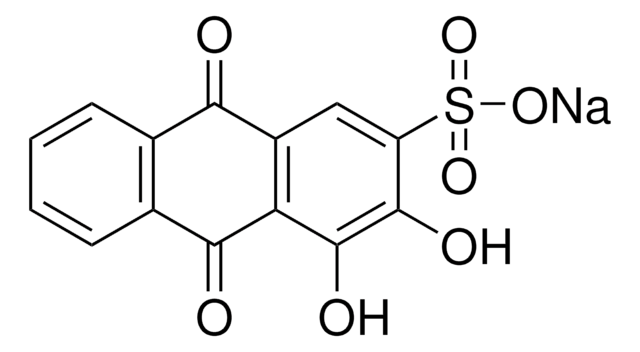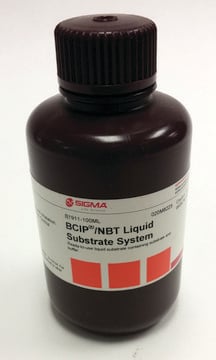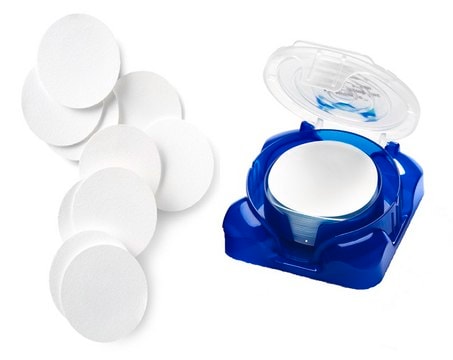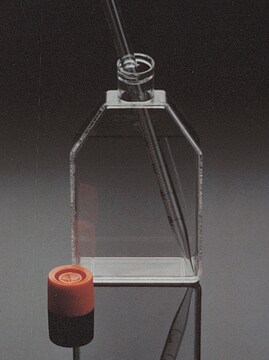추천 제품
일반 설명
Bone matrix is a dense mixture comprised mainly of collagen fibers and calcium phosphate particles, with a population of living cells contained within. Despite its rigidity, bone continually undergoes a remodeling process that requires the coordinated activity of two types of cells, osteoclasts and osteoblasts. Many diseases of bone including osteoporosis, a common phenomenon in post-menopausal women in which bone mass is greatly reduced, and osteogenesis imperfecta, also known as brittle-bone disease, are likely caused by the misregulation of osteoblasts and osteoclasts. Understanding the molecular mechanisms that underlie osteogenesis, the process by which new bone is formed, is thus of significant clinical importance.
Osteoclasts are related to macrophages, and erode the bone matrix by secreting acids and hydrolases to dissolve bone minerals and digest organic components. Osteoblasts arise from undifferentiated precursor cells, and deposit a mineralized matrix consisting of collagen, calcium, and phosphorous and other minerals, leading to the formation of new bone. Osteoblasts have also been shown to express factors which regulate the differentiation and function of osteoclasts [2]. The balance between the activity of osteoblasts and osteoclasts determines the mass and density of bone [1].
Studies of the mechanisms underlying osteogenesis have been greatly facilitated by the use of the undifferentiated preosteoblastic cell line MC3T3-E1, available from ATCC. This cell line was derived from mouse calvaria [3,4] and under defined culture conditions can be induced to undergo a developmental sequence leading to the formation of multilayered bone nodules [4,5]. This sequence is characterized by the replication of preosteoblasts followed by growth arrest and expression of mature osteoblastic characteristics such as matrix maturation and eventual formation of multilayered nodules with a mineralized extracellular matrix [5]. This cell line has become the standard in vitro model of osteogenesis and has found widespread use in studies examining many aspects and applications of osteogenesis, including transcriptional regulation [5], mineralization [3,6] and tissue engineering [7].
Millipore′s In Vitro Osteogenesis Assay Kit provides the necessary reagents and protocols for efficient in vitro differentiation of MC3T3-E1 cells to mature osteoblasts, and for the end-point determination and quantification of this process.
Application:
Millipore′s In Vitro Osteogenesis Assay Kit contains all reagents necessary to efficiently differentiate MC3T3-E1cells to a mature osteoblastic lineage, as determined by staining for mineralization. In addition this kit provides all the necessary reagents and a protocol for quantifying osteogenesis using a standard plate reader. This product is useful for studying the effects of growth factors, drugs and toxic agents on bone formation and for screening candidate osteogenic pharmaceuticals. Also, studies examining the intracellular signaling pathways regulating osteoblast differentiation can be facilitated by use of this kit.
The kit includes the osteogenesis-inducing reagents: ascorbic acid 2-phosphate, β-glycerophosphate and melatonin, and Alizarin Red Solution, a staining solution used to detect the presence of calcium in bone. Additionally, we provide reagents and a protocol for performing quantitative analysis of Alizarin Red staining.
Using Millipore′s In Vitro Osteogenesis Assay Kit, we routinely obtain >75% mature osteoblasts from a starting population of uninduced MC3T3-E1 cells obtained from ATCC. Efficiency of osteoblastic differentiation may vary, depending upon the quality of the cells used, and if variations to the protocol are introduced.
For Research Use Only. Not for use in diagnostic procedures.
Osteoclasts are related to macrophages, and erode the bone matrix by secreting acids and hydrolases to dissolve bone minerals and digest organic components. Osteoblasts arise from undifferentiated precursor cells, and deposit a mineralized matrix consisting of collagen, calcium, and phosphorous and other minerals, leading to the formation of new bone. Osteoblasts have also been shown to express factors which regulate the differentiation and function of osteoclasts [2]. The balance between the activity of osteoblasts and osteoclasts determines the mass and density of bone [1].
Studies of the mechanisms underlying osteogenesis have been greatly facilitated by the use of the undifferentiated preosteoblastic cell line MC3T3-E1, available from ATCC. This cell line was derived from mouse calvaria [3,4] and under defined culture conditions can be induced to undergo a developmental sequence leading to the formation of multilayered bone nodules [4,5]. This sequence is characterized by the replication of preosteoblasts followed by growth arrest and expression of mature osteoblastic characteristics such as matrix maturation and eventual formation of multilayered nodules with a mineralized extracellular matrix [5]. This cell line has become the standard in vitro model of osteogenesis and has found widespread use in studies examining many aspects and applications of osteogenesis, including transcriptional regulation [5], mineralization [3,6] and tissue engineering [7].
Millipore′s In Vitro Osteogenesis Assay Kit provides the necessary reagents and protocols for efficient in vitro differentiation of MC3T3-E1 cells to mature osteoblasts, and for the end-point determination and quantification of this process.
Application:
Millipore′s In Vitro Osteogenesis Assay Kit contains all reagents necessary to efficiently differentiate MC3T3-E1cells to a mature osteoblastic lineage, as determined by staining for mineralization. In addition this kit provides all the necessary reagents and a protocol for quantifying osteogenesis using a standard plate reader. This product is useful for studying the effects of growth factors, drugs and toxic agents on bone formation and for screening candidate osteogenic pharmaceuticals. Also, studies examining the intracellular signaling pathways regulating osteoblast differentiation can be facilitated by use of this kit.
The kit includes the osteogenesis-inducing reagents: ascorbic acid 2-phosphate, β-glycerophosphate and melatonin, and Alizarin Red Solution, a staining solution used to detect the presence of calcium in bone. Additionally, we provide reagents and a protocol for performing quantitative analysis of Alizarin Red staining.
Using Millipore′s In Vitro Osteogenesis Assay Kit, we routinely obtain >75% mature osteoblasts from a starting population of uninduced MC3T3-E1 cells obtained from ATCC. Efficiency of osteoblastic differentiation may vary, depending upon the quality of the cells used, and if variations to the protocol are introduced.
For Research Use Only. Not for use in diagnostic procedures.
애플리케이션
Note: Kit componenet 10X ARS Dilution Buffer: Part No. 2004810
One vial containing 5 mL of ARS (Alizarin Red Stain) Diluent is provided. Add 5 mL of 80% Acetic Acid for a final volume of 10 mL before use.
One vial containing 5 mL of ARS (Alizarin Red Stain) Diluent is provided. Add 5 mL of 80% Acetic Acid for a final volume of 10 mL before use.
Research Category
Cell Structure
Cell Structure
This In Vitro Osteogenesis Assay Kit provides the necessary reagents & protocols for efficient in vitro differentiation of MC3T3-E1 cells to mature osteoblasts & for the end-point determination & quantification of this process.
성분
Ascorbic Acid 2-Phosphate Solution (500X): Part No. 2004011 One vial containing 500 μL of 100 mM ascorbic acid 2-phosphate in deionized water. Store at -20°C.
Glycerol 2- Phosphate Solution (100X): Part No. 2004010 Three vials containing 1 mL of 1 M glycerol 2-phosphate in deionized water. Store at -20°C.
Melatonin Solution: Part No. 2004353 One vial containing 6 μg of melatonin. Reconstitute before use with 500 μL distilled H2O for a final concentration of 50 μM. Store at -20°C.
Alizarin Red S Stain Solution (1X): Part No. 2003999 One bottle containing 50 mL Alizarin Red S Solution. Store at 2°-8°C.
10% Acetic Acid: Part No. 2004807 One vial containing 20 mL of 10% Acetic Acid in deionized water. Store at 2°-8°C.
10% Ammonium Hydroxide: Part No. 2004809 One vial containing 10 mL of 10% Ammonium Hydroxide in deionized water. Store at 2°-8°C.
10X ARS Dilution Buffer: Part No. 2004810 One vial containing 5 mL of ARS (Alizarin Red Stain) Diluent. Add 5 mL of 80% Acetic Acid for a final volume of 10 mL before use. Store at 2°-8°C.
Glycerol 2- Phosphate Solution (100X): Part No. 2004010 Three vials containing 1 mL of 1 M glycerol 2-phosphate in deionized water. Store at -20°C.
Melatonin Solution: Part No. 2004353 One vial containing 6 μg of melatonin. Reconstitute before use with 500 μL distilled H2O for a final concentration of 50 μM. Store at -20°C.
Alizarin Red S Stain Solution (1X): Part No. 2003999 One bottle containing 50 mL Alizarin Red S Solution. Store at 2°-8°C.
10% Acetic Acid: Part No. 2004807 One vial containing 20 mL of 10% Acetic Acid in deionized water. Store at 2°-8°C.
10% Ammonium Hydroxide: Part No. 2004809 One vial containing 10 mL of 10% Ammonium Hydroxide in deionized water. Store at 2°-8°C.
10X ARS Dilution Buffer: Part No. 2004810 One vial containing 5 mL of ARS (Alizarin Red Stain) Diluent. Add 5 mL of 80% Acetic Acid for a final volume of 10 mL before use. Store at 2°-8°C.
저장 및 안정성
Kit components require two different storage temperatures. Ascorbic Acid 2-Phosphate Solution, Glycerol 2- Phosphate Solution and Melatonin Solution should be stored at -20°C. Alizarin Red Solution, 10% Acetic Acid, 10% Ammonium Hydroxide and ARS Dilutio
법적 정보
CHEMICON is a registered trademark of Merck KGaA, Darmstadt, Germany
면책조항
Unless otherwise stated in our catalog or other company documentation accompanying the product(s), our products are intended for research use only and are not to be used for any other purpose, which includes but is not limited to, unauthorized commercial
신호어
Danger
유해 및 위험 성명서
Hazard Classifications
Aquatic Acute 1 - Aquatic Chronic 2 - Eye Dam. 1 - Skin Corr. 1B - Skin Sens. 1 - STOT SE 3
표적 기관
Respiratory system
Storage Class Code
8A - Combustible corrosive hazardous materials
시험 성적서(COA)
제품의 로트/배치 번호를 입력하여 시험 성적서(COA)을 검색하십시오. 로트 및 배치 번호는 제품 라벨에 있는 ‘로트’ 또는 ‘배치’라는 용어 뒤에서 찾을 수 있습니다.
Marxa L Figueiredo et al.
Molecular therapy. Methods & clinical development, 17, 739-751 (2020-04-30)
We have examined the role of a novel targeted cytokine, interleukin-27 (IL-27), modified at the C terminus with a dual targeting and therapeutic heptapeptide, in treating prostate cancer. IL-27 has shown promise in halting tumor growth and mediating tumor regression
자사의 과학자팀은 생명 과학, 재료 과학, 화학 합성, 크로마토그래피, 분석 및 기타 많은 영역을 포함한 모든 과학 분야에 경험이 있습니다..
고객지원팀으로 연락바랍니다.











